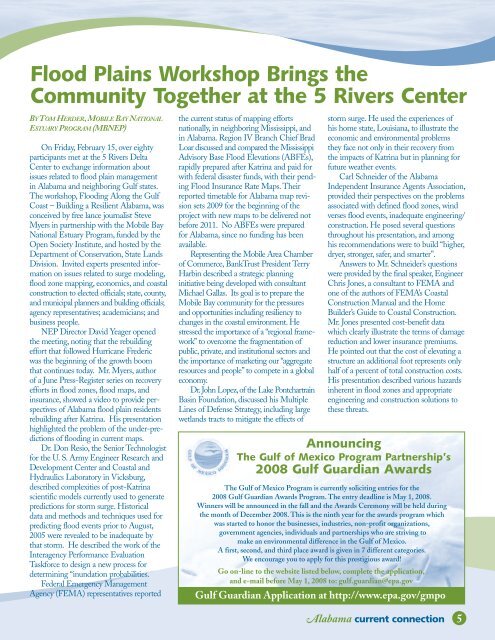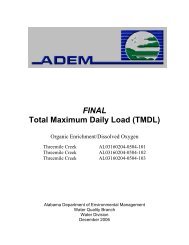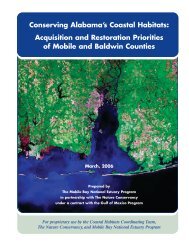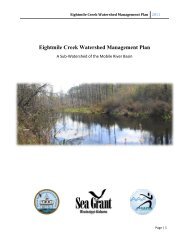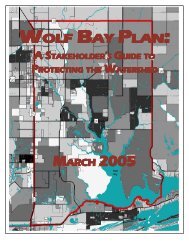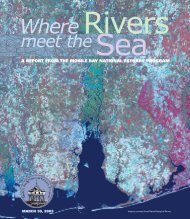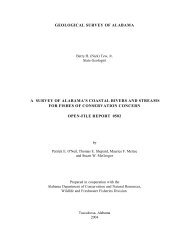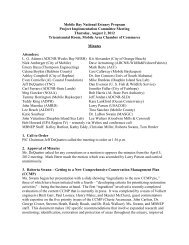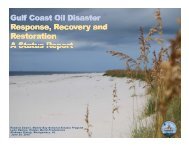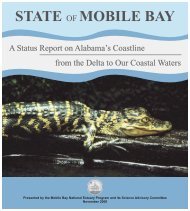Alabama Current Connection - Mobile Bay National Estuary Program
Alabama Current Connection - Mobile Bay National Estuary Program
Alabama Current Connection - Mobile Bay National Estuary Program
Create successful ePaper yourself
Turn your PDF publications into a flip-book with our unique Google optimized e-Paper software.
Flood Plains Workshop Brings the<br />
Community Together at the 5 Rivers Center<br />
BY TOM HERDER, MOBILE BAY NATIONAL<br />
ESTUARY PROGRAM (MBNEP)<br />
On Friday, February 15, over eighty<br />
participants met at the 5 Rivers Delta<br />
Center to exchange information about<br />
issues related to flood plain management<br />
in <strong>Alabama</strong> and neighboring Gulf states.<br />
The workshop, Flooding Along the Gulf<br />
Coast – Building a Resilient <strong>Alabama</strong>, was<br />
conceived by free lance journalist Steve<br />
Myers in partnership with the <strong>Mobile</strong> <strong>Bay</strong><br />
<strong>National</strong> <strong>Estuary</strong> <strong>Program</strong>, funded by the<br />
Open Society Institute, and hosted by the<br />
Department of Conservation, State Lands<br />
Division. Invited experts presented information<br />
on issues related to surge modeling,<br />
flood zone mapping, economics, and coastal<br />
construction to elected officials; state, county,<br />
and municipal planners and building officials;<br />
agency representatives; academicians; and<br />
business people.<br />
NEP Director David Yeager opened<br />
the meeting, noting that the rebuilding<br />
effort that followed Hurricane Frederic<br />
was the beginning of the growth boom<br />
that continues today. Mr. Myers, author<br />
of a June Press-Register series on recovery<br />
efforts in flood zones, flood maps, and<br />
insurance, showed a video to provide perspectives<br />
of <strong>Alabama</strong> flood plain residents<br />
rebuilding after Katrina. His presentation<br />
highlighted the problem of the under-predictions<br />
of flooding in current maps.<br />
Dr. Don Resio, the Senior Technologist<br />
for the U. S. Army Engineer Research and<br />
Development Center and Coastal and<br />
Hydraulics Laboratory in Vicksburg,<br />
described complexities of post-Katrina<br />
scientific models currently used to generate<br />
predictions for storm surge. Historical<br />
data and methods and techniques used for<br />
predicting flood events prior to August,<br />
2005 were revealed to be inadequate by<br />
that storm. He described the work of the<br />
Interagency Performance Evaluation<br />
Taskforce to design a new process for<br />
determining “inundation probabilities.<br />
Federal Emergency Management<br />
Agency (FEMA) representatives reported<br />
the current status of mapping efforts<br />
nationally, in neighboring Mississippi, and<br />
in <strong>Alabama</strong>. Region IV Branch Chief Brad<br />
Loar discussed and compared the Mississippi<br />
Advisory Base Flood Elevations (ABFEs),<br />
rapidly prepared after Katrina and paid for<br />
with federal disaster funds, with their pending<br />
Flood Insurance Rate Maps.Their<br />
reported timetable for <strong>Alabama</strong> map revision<br />
sets 2009 for the beginning of the<br />
project with new maps to be delivered not<br />
before 2011. No ABFEs were prepared<br />
for <strong>Alabama</strong>, since no funding has been<br />
available.<br />
Representing the <strong>Mobile</strong> Area Chamber<br />
of Commerce, BankTrust President Terry<br />
Harbin described a strategic planning<br />
initiative being developed with consultant<br />
Michael Gallas. Its goal is to prepare the<br />
<strong>Mobile</strong> <strong>Bay</strong> community for the pressures<br />
and opportunities including resiliency to<br />
changes in the coastal environment. He<br />
stressed the importance of a “regional framework”<br />
to overcome the fragmentation of<br />
public, private, and institutional sectors and<br />
the importance of marketing our “aggregate<br />
resources and people” to compete in a global<br />
economy.<br />
Dr.John Lopez,of the Lake Pontchartrain<br />
Basin Foundation, discussed his Multiple<br />
Lines of Defense Strategy, including large<br />
wetlands tracts to mitigate the effects of<br />
storm surge. He used the experiences of<br />
his home state, Louisiana, to illustrate the<br />
economic and environmental problems<br />
they face not only in their recovery from<br />
the impacts of Katrina but in planning for<br />
future weather events.<br />
Carl Schneider of the <strong>Alabama</strong><br />
Independent Insurance Agents Association,<br />
provided their perspectives on the problems<br />
associated with defined flood zones, wind<br />
verses flood events, inadequate engineering/<br />
construction. He posed several questions<br />
throughout his presentation, and among<br />
his recommendations were to build “higher,<br />
dryer, stronger, safer, and smarter”.<br />
Answers to Mr. Schneider’s questions<br />
were provided by the final speaker, Engineer<br />
Chris Jones, a consultant to FEMA and<br />
one of the authors of FEMA’s Coastal<br />
Construction Manual and the Home<br />
Builder’s Guide to Coastal Construction.<br />
Mr. Jones presented cost-benefit data<br />
which clearly illustrate the terms of damage<br />
reduction and lower insurance premiums.<br />
He pointed out that the cost of elevating a<br />
structure an additional foot represents only<br />
half of a percent of total construction costs.<br />
His presentation described various hazards<br />
inherent in flood zones and appropriate<br />
engineering and construction solutions to<br />
these threats.<br />
Announcing<br />
The Gulf of Mexico <strong>Program</strong> Partnership’s<br />
2008 Gulf Guardian Awards<br />
The Gulf of Mexico <strong>Program</strong> is currently soliciting entries for the<br />
2008 Gulf Guardian Awards <strong>Program</strong>. The entry deadline is May 1, 2008.<br />
Winners will be announced in the fall and the Awards Ceremony will be held during<br />
the month of December 2008. This is the ninth year for the awards program which<br />
was started to honor the businesses, industries, non-profit organizations,<br />
government agencies, individuals and partnerships who are striving to<br />
make an environmental difference in the Gulf of Mexico.<br />
A first, second, and third place award is given in 7 different categories.<br />
We encourage you to apply for this prestigious award!<br />
Go on-line to the website listed below, complete the application,<br />
and e-mail before May 1, 2008 to: gulf.guardian@epa.gov<br />
Gulf Guardian Application at http://www.epa.gov/gmpo<br />
<strong>Alabama</strong> current connection 5


